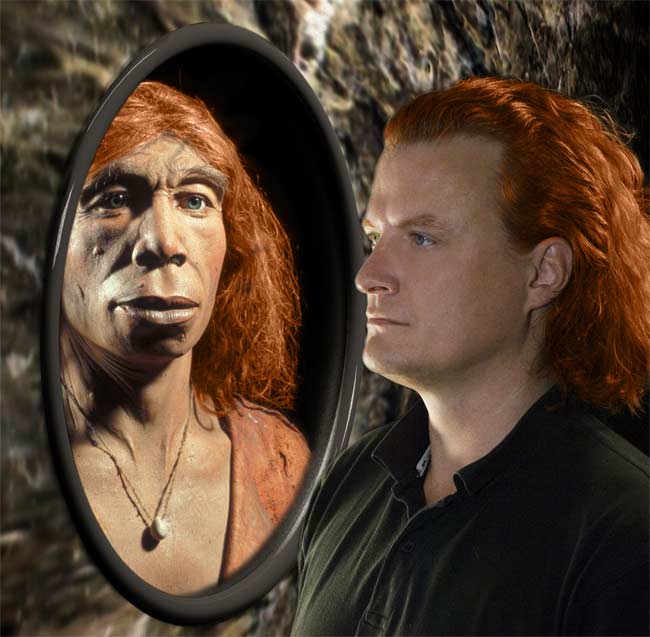Some Neanderthals Were Redheads

Like bringing to life a naked mannequin, scientists are using genetic and physical evidence found in fossils to clothe the skeletal remains of our closest hominid relatives, the Neanderthals.
More and more, they seem familiar.
Bones from two Neanderthals yielded valuable genetic information that adds red hair, light skin and perhaps some freckling to our extinct relatives. The results, detailed online today by the journal Science, suggest that at least 1 percent of Neanderthals were redheads.
"We can't say anything for the actual fossils we looked at, but we can be sure that part of the Neanderthal population was red-haired," said study team member Michael Hofreiter of the Max Planck Institute for Evolutionary Anthropology in Leipzig, Germany.
Earlier this month, other scientists reported genetic evidence that Neanderthals may have spoken similar to how we do today.
Pigment gene
Neanderthals inhabited the plains of Europe and parts of Asia as far back as 230,000 years ago. They disappeared from the fossil record more than 20,000 years ago, a few thousand years after modern humans appeared on the scene.
Sign up for the Live Science daily newsletter now
Get the world’s most fascinating discoveries delivered straight to your inbox.
Holger Rompler of the University of Leipzig, Carles Lalueza-Fox of the University of Barcelona in Spain, and their colleagues extracted the mc1r gene from the bones of a 43,000-year-old Neanderthal from El Sidron, Spain, and a 50,000-year-old specimen from Monti Lessini, Italy. They found that both Neanderthal specimens contained a unique variant of the gene, one that was not found in nearly 4,000 modern humans they compared it with (including the scientists themselves).
The gene is responsible for producing a protein that helps regulate the balance between the red-and-yellow pigment pheomelanin and the black-and-brown eumelanin. Modern people with relatively inactive mc1r receptors tend to have red hair and pale skin. However, other pigmentation genes also contribute to hair and skin coloring.
A past study led by Rompler found a variant of the same gene in woolly mammoth bones, providing evidence that some of the ice-age beasts sported light-colored coats.
In the current study, the researchers tweaked a human mc1r gene so that it matched the variant found in Neanderthals. When they put the gene into modern human cells, it functioned in melatonin production as the modern variants do, suggesting some Neanderthals had fair skin and red hair.
Strawberry blondes
Neanderthals have been portrayed by scientists and even in artistic creations as redheads, but this is the first real evidence for the fiery feature that is thought to be beneficial to modern Europeans.
"What we can say is most likely at least 1 percent, but possibly more, probably more, of the Neanderthals had two copies of the inactive variant and these would have been red-haired," Hofreiter told LiveScience.
At high latitudes where the Neanderthals resided in Europe, the UV radiation would've been minimal. And so fair skin, which has little protection from the sunny rays, would mean the individuals could absorb enough of the UV to produce vitamin D in sufficient amounts.
"Lighter skin is adaptive because vitamin D production depends on UV radiation," Hofreiter said.
And like today's redheads, the researchers think Neanderthals featured a spectrum of red hair, from auburn to brilliant red to strawberry blonde.
"This is my guess. They probably had the whole range like present-day northern Europeans," Lalueza-Fox said.
- Video: Similarities Between Humans and Other Primates
- 10 Things You Didn't Know About You
- Top 10 Missing Links
Jeanna Bryner is managing editor of Scientific American. Previously she was editor in chief of Live Science and, prior to that, an editor at Scholastic's Science World magazine. Bryner has an English degree from Salisbury University, a master's degree in biogeochemistry and environmental sciences from the University of Maryland and a graduate science journalism degree from New York University. She has worked as a biologist in Florida, where she monitored wetlands and did field surveys for endangered species, including the gorgeous Florida Scrub Jay. She also received an ocean sciences journalism fellowship from the Woods Hole Oceanographic Institution. She is a firm believer that science is for everyone and that just about everything can be viewed through the lens of science.










